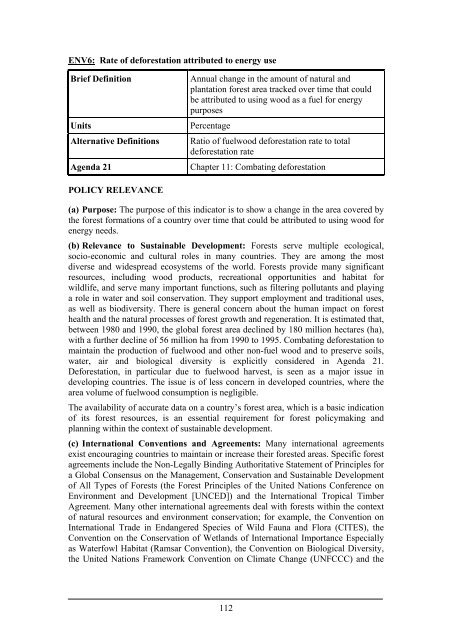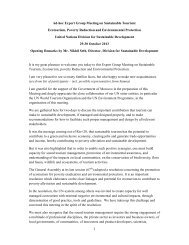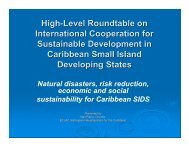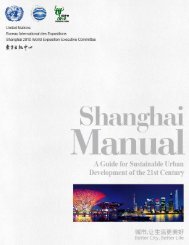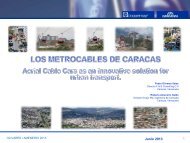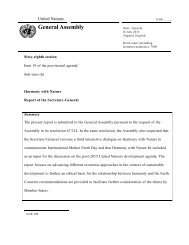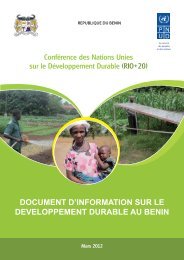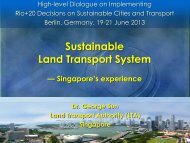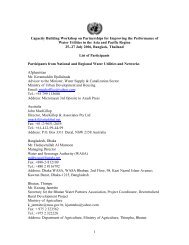Energy Indicators for Sustainable Development ... - IAEA Publications
Energy Indicators for Sustainable Development ... - IAEA Publications
Energy Indicators for Sustainable Development ... - IAEA Publications
Create successful ePaper yourself
Turn your PDF publications into a flip-book with our unique Google optimized e-Paper software.
ENV6: Rate of de<strong>for</strong>estation attributed to energy useBrief DefinitionUnitsAlternative DefinitionsAgenda 21Annual change in the amount of natural andplantation <strong>for</strong>est area tracked over time that couldbe attributed to using wood as a fuel <strong>for</strong> energypurposesPercentageRatio of fuelwood de<strong>for</strong>estation rate to totalde<strong>for</strong>estation rateChapter 11: Combating de<strong>for</strong>estationPOLICY RELEVANCE(a) Purpose: The purpose of this indicator is to show a change in the area covered bythe <strong>for</strong>est <strong>for</strong>mations of a country over time that could be attributed to using wood <strong>for</strong>energy needs.(b) Relevance to <strong>Sustainable</strong> <strong>Development</strong>: Forests serve multiple ecological,socio-economic and cultural roles in many countries. They are among the mostdiverse and widespread ecosystems of the world. Forests provide many significantresources, including wood products, recreational opportunities and habitat <strong>for</strong>wildlife, and serve many important functions, such as filtering pollutants and playinga role in water and soil conservation. They support employment and traditional uses,as well as biodiversity. There is general concern about the human impact on <strong>for</strong>esthealth and the natural processes of <strong>for</strong>est growth and regeneration. It is estimated that,between 1980 and 1990, the global <strong>for</strong>est area declined by 180 million hectares (ha),with a further decline of 56 million ha from 1990 to 1995. Combating de<strong>for</strong>estation tomaintain the production of fuelwood and other non-fuel wood and to preserve soils,water, air and biological diversity is explicitly considered in Agenda 21.De<strong>for</strong>estation, in particular due to fuelwood harvest, is seen as a major issue indeveloping countries. The issue is of less concern in developed countries, where thearea volume of fuelwood consumption is negligible.The availability of accurate data on a country’s <strong>for</strong>est area, which is a basic indicationof its <strong>for</strong>est resources, is an essential requirement <strong>for</strong> <strong>for</strong>est policymaking andplanning within the context of sustainable development.(c) International Conventions and Agreements: Many international agreementsexist encouraging countries to maintain or increase their <strong>for</strong>ested areas. Specific <strong>for</strong>estagreements include the Non-Legally Binding Authoritative Statement of Principles <strong>for</strong>a Global Consensus on the Management, Conservation and <strong>Sustainable</strong> <strong>Development</strong>of All Types of Forests (the Forest Principles of the United Nations Conference onEnvironment and <strong>Development</strong> [UNCED]) and the International Tropical TimberAgreement. Many other international agreements deal with <strong>for</strong>ests within the contextof natural resources and environment conservation; <strong>for</strong> example, the Convention onInternational Trade in Endangered Species of Wild Fauna and Flora (CITES), theConvention on the Conservation of Wetlands of International Importance Especiallyas Waterfowl Habitat (Ramsar Convention), the Convention on Biological Diversity,the United Nations Framework Convention on Climate Change (UNFCCC) and the112


